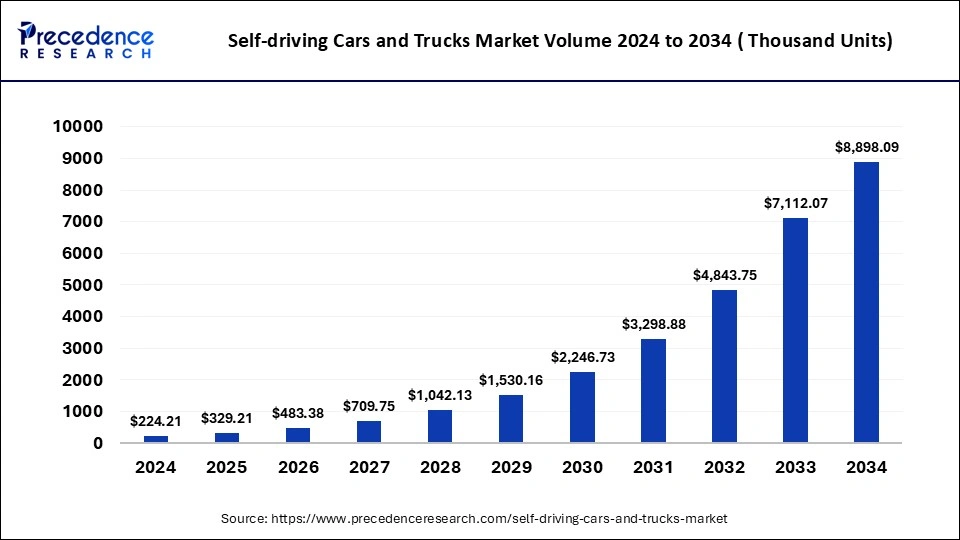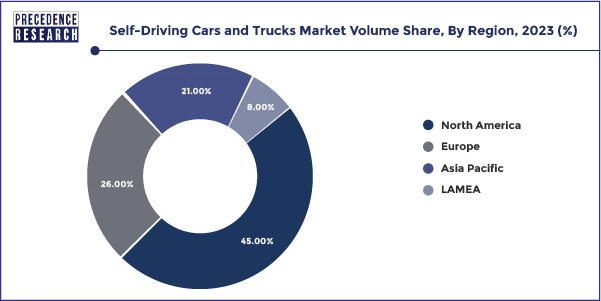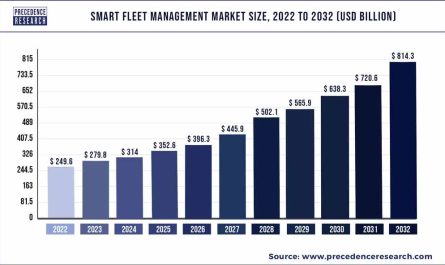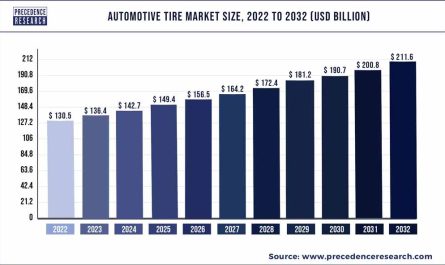The global self-driving cars and trucks market volume is estimated at 224.21 thousand units in 2024 and is projected to hit around 7112.07 thousand units by 2033 with a noteworthy CAGR of 46.83% from 2024 to 2033.

The self-driving cars and trucks market is rapidly evolving with advancements in autonomous vehicle technology. These vehicles utilize a combination of sensors, cameras, and artificial intelligence algorithms to navigate roads and make decisions without human intervention. Key players in the market include automotive manufacturers, technology companies, and startups, all competing to develop and deploy safe and efficient autonomous driving solutions.
Get a Sample: https://www.precedenceresearch.com/sample/4581
Self-driving Cars and Trucks Market Key Points
- North America dominated the market with the largest volume share of 45% in 2023.
- Europe is projected to expand at a rapid pace in the market during the forecast period.
- By application, the transportation segment has contributed more than 93% of volume share in 2023.
- By application, the defense segment is expected to witness significant growth in the market during the forecast period.
Regional Insights
The self-driving cars and trucks market is experiencing rapid growth globally, driven by advancements in artificial intelligence and automation technologies. North America holds a significant share due to early adoption and substantial investments by tech giants and automotive companies in developing autonomous vehicles. The region benefits from supportive regulatory frameworks and robust infrastructure for testing and deployment.
- The North America self-driving cars and trucks market volume was exhibited at 68.72 thousand units in 2023 and is projected to be worth around 3,235.99 thousand units by 2033, poised to grow at a CAGR of 46.99% from 2024 to 2033.

Europe follows closely, with countries like Germany and the UK leading in research and development efforts, bolstered by stringent safety standards and favorable government initiatives. Asia Pacific is emerging as a key market, particularly in countries like Japan, China, and South Korea, where technological innovation and urbanization are driving demand for autonomous transportation solutions. These regions are poised to witness continued growth as autonomous vehicle technologies mature and gain acceptance across various sectors.
Self-Driving Cars and Trucks Market Trends
- Advancements in AI and Sensor Technologies: Continued advancements in artificial intelligence (AI), machine learning, and sensor technologies are enhancing the capabilities of autonomous vehicles. This includes improved object detection, decision-making algorithms, and real-time data processing.
- Increased Investments and Partnerships: Major automakers, technology companies, and startups are investing heavily in self-driving technologies. Partnerships between traditional automakers and tech firms are becoming common to leverage expertise and accelerate development.
- Regulatory Developments: Governments are developing frameworks and regulations to support the testing and deployment of autonomous vehicles. Countries like the US, China, and some European nations have rolled out guidelines and pilot programs to facilitate autonomous vehicle testing on public roads.
- Rise of Autonomous Fleets: Companies are exploring autonomous vehicle fleets for ride-hailing, delivery services, and logistics. This includes both passenger cars and trucks, aiming to improve efficiency, reduce operational costs, and enhance safety.
- Integration with Smart Cities: Autonomous vehicles are expected to play a crucial role in smart city initiatives. Integration with smart infrastructure, such as connected traffic lights and vehicle-to-infrastructure communication, can optimize traffic flow and enhance safety.
Self-driving Cars and Trucks Market Scope
| Report Coverage | Details |
| Market Volume by 2033 | 7112.07 Thousand Units |
| Market Volume in 2023 | 152.70 Thousand Units |
| Market Volume in 2024 | 224.21 Thousand Units |
| Market Growth Rate from 2024 to 2033 | CAGR of 46.83% |
| Largest Market | North America |
| Base Year | 2023 |
| Forecast Period | 2024 to 2033 |
| Regions Covered | North America, Europe, Asia-Pacific, Latin America, and Middle East & Africa |
Self-driving Cars and Trucks Market Dynamics
Drivers
Several factors drive the growth of the self-driving cars and trucks market. Firstly, increasing consumer demand for safer and more convenient transportation solutions fuels adoption. Autonomous vehicles promise to reduce accidents caused by human error and offer enhanced mobility options for elderly and disabled individuals. Secondly, governments worldwide are investing in infrastructure and regulations to support autonomous vehicle deployment, creating a conducive environment for market growth. Additionally, advancements in sensor technology, machine learning, and connectivity further accelerate innovation in autonomous driving systems.
Opportunities
The market presents significant opportunities across various sectors. Fleet operators stand to benefit from reduced operating costs and increased efficiency through autonomous trucks and delivery vehicles. In urban transportation, autonomous taxis and shuttles promise to transform public transit by offering on-demand services and reducing congestion. Moreover, industries such as logistics, mining, and agriculture are exploring autonomous solutions to optimize operations and improve productivity. Collaborations between automotive manufacturers and tech companies also open doors for new business models and revenue streams in the autonomous vehicle ecosystem.
Challenges
Despite promising growth prospects, the self-driving cars and trucks market faces several challenges. Safety remains a primary concern, as ensuring the reliability and accuracy of autonomous systems is crucial for widespread adoption. Regulatory frameworks vary globally and must evolve to address legal and ethical considerations surrounding autonomous vehicles. Technical hurdles such as navigating complex urban environments, adverse weather conditions, and integrating seamlessly with existing infrastructure pose significant challenges. Moreover, addressing public skepticism and gaining trust in autonomous technology requires extensive testing, validation, and transparent communication about the benefits and limitations of self-driving vehicles.
Read Also: Electric Vehicle Sensor Market Size to Reach USD 53.75 Bn by 2033
Application Segments in the Self-Driving Cars and Trucks Market
The application segments in the self-driving cars and trucks market encompass a wide range of uses across various industries and consumer needs.
- 1. Passenger Vehicles: Self-driving technology in passenger vehicles aims to revolutionize personal transportation by offering convenience, safety, and potentially reducing traffic congestion. These vehicles are designed to navigate urban environments and highways autonomously, enhancing the commuting experience for individuals and families alike.
- 2. Commercial Transportation: In the commercial sector, self-driving trucks hold significant promise for logistics and transportation companies. Automated trucks can potentially reduce labor costs, improve efficiency in long-haul freight operations, and enhance overall supply chain management by optimizing routes and reducing delivery times.
- 3. Public Transportation: Self-driving technology is also being explored for use in public transportation systems such as buses and shuttles. Autonomous buses can provide reliable and safe transit options in urban areas, offering a solution to last-mile connectivity challenges and improving accessibility for passengers.
- 4. Delivery Services: Autonomous vehicles are increasingly being tested and deployed for package delivery services. Companies are exploring the use of self-driving cars and trucks to enhance the speed and efficiency of deliveries, particularly in urban areas where traffic congestion and parking can be significant challenges.
- 5. Industrial Applications: Beyond transportation, self-driving technology is finding applications in industrial settings such as mining and agriculture. Autonomous vehicles can operate in hazardous environments or perform repetitive tasks with precision, thereby enhancing worker safety and operational efficiency.
Self-driving Cars and Trucks Market Companies
- Tata Elxsi
- Hyundai Motor Group
- Audi AG
- BMW AG
- Daimler AG
- Ford Motor Company
- General Motors Company
- Toyota Motor Corporation
- Uber Technologies, Inc.
- Volvo Car Corporation
- Audi AG
- BMW AG
- Mercedes-Benz Group AG
- Volkswagen AG
- Jaguar Land Rover Limited
- Groupe Renault
- Volvo Car Corporation
- Aptiv PLC
- Waymo LLC
- Tesla, Inc.
- Honda Motor Co., Ltd.
- Nissan Motor Co., Ltd.
- Mitsubishi Motors Corporation
- Beijing Idriveplus Technology Co., Ltd.
- SAIC Motor Corp.
Recent Developments
- In June 2024, Amazon.com’s robotaxi unit Zoox announced it plans to start testing its autonomous vehicles in Austin, Texas, and Miami, a move that would mark its first trial sites outside the western United States. Zoox will deploy its test fleet of retrofitted Toyota Highlanders with human safety drivers in small areas near the business and entertainment districts of the two cities.
- In March 2023, Google LLC, a U.S.-based technology company, collaborated with Mercedes-Benz, a luxury vehicle company in Germany, to develop a customized navigation interface. This collaboration aims to use Google’s AI and data functionalities to help Mercedes-Benz accelerate its sustainability efforts, advance autonomous driving, and improve the customer experience.
- In May 2024, Japan’s Defense Ministry announced its plan to set up a technology research center this fall to develop applications for innovations such as artificial intelligence, aiming to encourage cooperation with the private sector like that seen in the U.S.
- In June 2024, Tesla unveiled a new tab that released a software upgrade for its in-car navigation system in China on Friday, introducing new features such as displaying lane markings on its maps that correspond to the actual lanes on the road.


